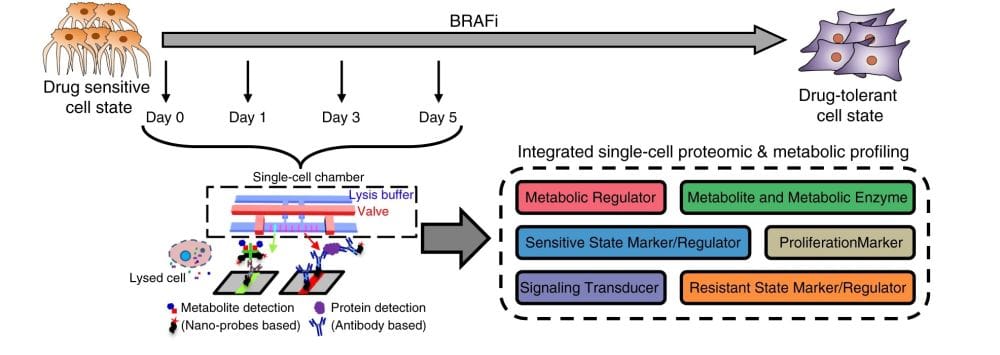
15 May Microfluidic single-cell barcode chip (SCBC) reveals multiple trajectories to drug tolerance in cancer cells
Cell-state change is referred to as a process in which the cell undergoes a change in its state and can range from stem cell differentiation to a change in drug-tolerance. For example, a cancer cell initially prone to inhibitors can develop into a drug-resistant mode. Understanding the trajectory that the cells traverse from a responsive mode to a resistant state can lead to the development of treatments to arrest this transition. It can also provide a better understanding of the epigenetic response of the cells exposed to anti-cancer drugs.
A microfluidic single-cell barcode chip (SCBC) has recently been developed by an international multi-disciplinary team of researchers to uncover the independent trajectories from a drug-naïve to a drug-tolerant state in a melanoma cell line. The results of this research were published in Nature Communication journal and revealed a landscape of the paths that connect these two states over 5 days. Two paths were discovered each showing a different druggable susceptibility.

Reproduced under creative commons license.
The single-cell barcode chip (SCBC) is a microchip initially developed by Ma et al. in 2011 for heterogeneity assessment single-cell level. This microfluidic chip consists of a microarray glass slide made with microchannel guided flows bonded to a two-layer PDMS chip. The microfluidic device includes microchannels to house the cells and expose them to the microarray probes, control valves to isolate the cells in microchambers and inlet/outlet ports to introduce and collect the samples. The bottom layer of the single-cell barcode chip consists of 80 microchannels while the top layer consists of 13 sets of valves that can create a total of 1040 microchambers of nL volume scale.
The team used a patient-derived BRAFV600E mutant melanoma cancer cell line that can rapidly develop into a drug-tolerant state in the presence of inhibitors. To characterize the transition from the sensitive to tolerant states, the SCBC microchip was used to sample proteins and metabolites associated with cancer-cell hallmarks. It was found that even in isogenic samples, the cells can follow different trajectories towards drug-resistance each associated with distinct signaling and metabolic network.
“This finding challenges the current paradigm of targeted inhibitor resistance development and also provides guidelines for assessing the value of combination therapies.”, the authors explained.
The findings of this research can update the current understanding of how cancer cells develop into drug-resistant modes and can be used for identifying novel therapeutic approaches.
Read the original article: Multi-omic single-cell snapshots reveal multiple independent trajectories to drug tolerance in a melanoma cell line

Pouriya Bayat
Pouriya is a microfluidic production engineer at uFluidix. He received his B.Sc. and M.A.Sc. both in Mechanical Engineering from Isfahan University of Technology and York University, respectively. During his master's studies, he had the chance to learn the foundations of microfluidic technology at ACUTE Lab where he focused on designing microfluidic platforms for cell washing and isolation. Upon graduation, he joined uFluidix to even further enjoy designing, manufacturing, and experimenting with microfluidic chips. In his free time, you might find him reading a psychology/philosophy/fantasy book while refilling his coffee every half an hour. Is there a must-read book in your mind, do not hesitate to hit him up with your to-read list.


